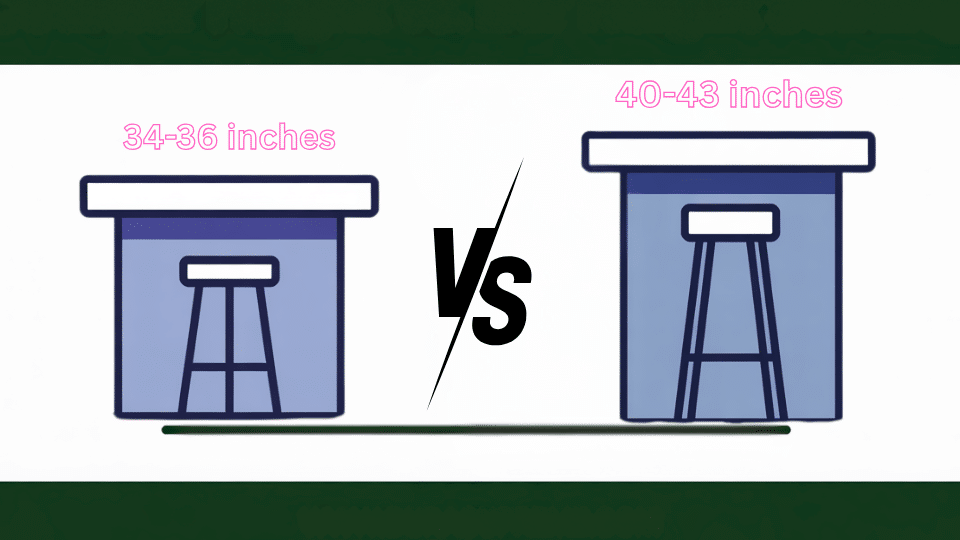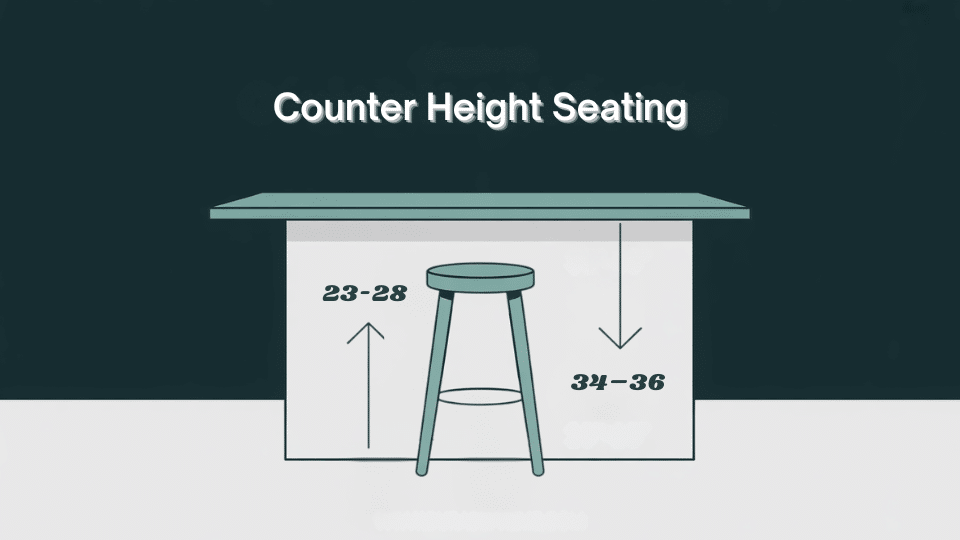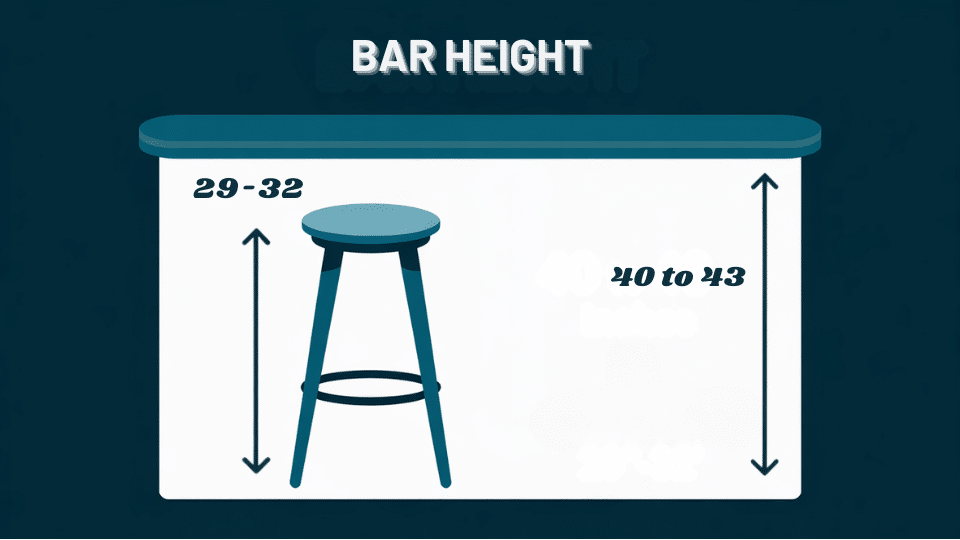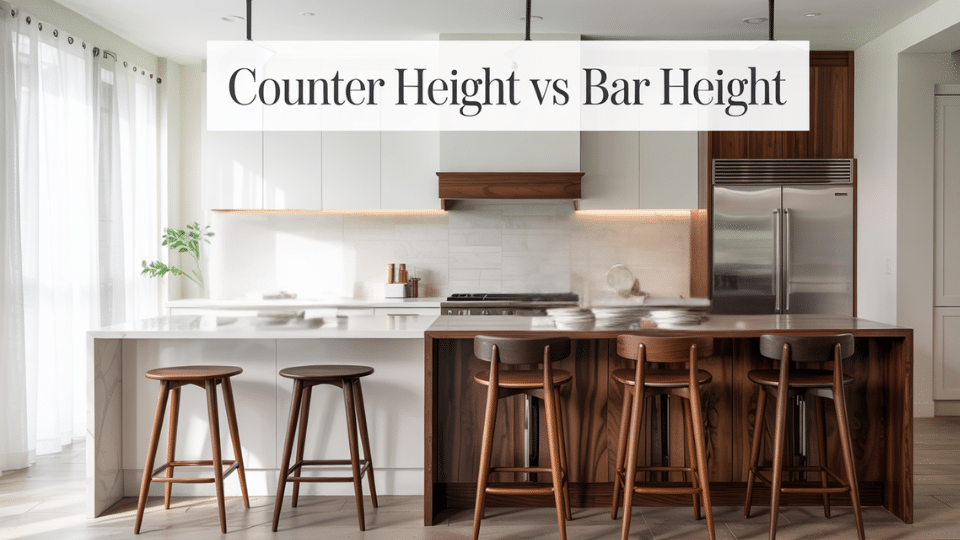Choosing the right height for your kitchen island can significantly enhance or detract from your daily cooking experience and social gatherings.
This decision affects everything from comfort during meal prep to how easily your family can interact around the island.
Counter height surfaces sit at 34-36 inches, offering family-friendly accessibility and seamless integration with existing countertops.
Bar height surfaces stand taller at 40-43 inches, creating a more social atmosphere perfect for entertaining.
In this guide, we’ll break down the key differences between these two popular heights, helping you make an informed decision.
By the end, you’ll know exactly which height suits your home best.
Counter Height vs Bar Height: A Quick Comparison
Uncover the key differences between counter height and bar height furniture to find the ideal fit for your kitchen or bar area.
1. Height Measurements
Counter Height: Stands at 34-36 inches, matching standard kitchen countertops for a uniform look throughout your space. This measurement works well with existing cabinetry, creating visual continuity.
Bar Height: Measures 40-43 inches, creating a more dramatic vertical element that draws the eye upward. The extra height adds architectural interest and can make ceilings appear higher.
2. Stool Height Compatibility
Counter Height: Pairs with 24-27 inch stools, offering a wide selection of affordable seating options in various styles. The lower seat height makes it easy for people to get on and off comfortably.
Bar Height: Requires 28-33 inch stools, which tend to be more expensive but offer a sophisticated pub-like appearance. These taller stools often feature footrests for added comfort during extended periods of sitting.
3. Best Use Cases
Counter Height: Perfect for family dining, homework sessions, food preparation, and casual meals where comfort is a priority. Works well in compact kitchens where space efficiency is a top priority.
Bar Height: Ideal for entertaining guests, creating a separation between the kitchen and living areas, and for quick breakfast spots. Best suited for homes with open floor plans that require defining different zones.
4. Accessibility and Comfort
Counter Height: More accessible for children, elderly family members, and people with mobility concerns. The lower height reduces strain when sitting or standing and feels more inclusive for all ages.
Bar Height: Better suited for taller individuals, but can be challenging for shorter people and children to use comfortably. May require assistance for some family members to safely climb onto stools.
5. Visual Impact on Space
Counter Height: Creates a more relaxed, family-friendly atmosphere while maintaining visual connection across the kitchen. Keeps sight lines open and makes spaces feel more connected and casual.
Bar Height: Makes a bold design statement and can serve as a room divider while maintaining an open feel. Creates a more formal, restaurant-like feel that impresses guests and adds sophistication to your home.
What is Counter Height?
Counter height refers to surfaces that typically measure between 34 and 36 inches tall, making them slightly higher than standard dining tables but lower than bar-style surfaces.
This height creates a comfortable workspace that allows people to stand and work while also providing a casual dining or socializing area.
Counter height has become the go-to choice for many homeowners because it strikes the perfect balance between functionality and comfort, accommodating both seated and standing activities with ease.
Common Uses for counter height:
- Kitchen islands for meal prep and casual dining
- Breakfast nooks and eating kitchen areas
- Home office workstations and study spaces
- Craft rooms and hobby areas
- Laundry room folding stations
- Outdoor patio dining sets
- Coffee bars and beverage stations
Counter height surfaces blend seamlessly with standard kitchen countertops, creating a cohesive look that supports both cooking activities and social interaction.
This height allows people to sit comfortably while maintaining good posture, making it ideal for extended use during meal prep or casual dining experiences.
The Pros and Cons of Counter Height
| Pros of Counter Height | Cons of Counter Height |
|---|---|
| Comfortable for most people (34–36 inches is ideal for daily tasks). | Less comfortable for tall individuals (may feel too low). |
| Family-friendly and accessible (easier for children and seniors). | Limited storage space underneath (fewer cabinets or drawers). |
| Expands space visually, making kitchens feel larger. | Doesn’t hide clutter (everything is visible on the counter). |
| Multifunctional (works for cooking, dining, homework, and socializing). | Doesn’t provide the elevated, bar-like experience. |
| More affordable (fewer materials used). | May lack the same “bar” vibe or social atmosphere. |
What is Bar Height?
Bar height surfaces stand taller at 40 to 43 inches, creating a more dramatic and social atmosphere in your kitchen or dining space.
This raised design originated from traditional pub and restaurant settings, where the taller surface encourages standing conversations and creates a lively social hub.
Bar height works exceptionally well for homeowners who love entertaining guests and want to make a sophisticated, restaurant-like feel in their homes.
Common Uses for Bar Height:
- Perfect for quick morning meals and coffee breaks
- Create a natural gathering spot for parties and social events
- Brings restaurant ambiance to home kitchens
- Help define spaces while maintaining visual flow
- Ideal for households with tall family members
- A higher surface helps hide kitchen mess from guests
- Great for tasks that require standing positions
Bar height surfaces offer several advantages for modern homes, including better sight lines across open floor plans and improved socializing opportunities.
Taller individuals often find this height more comfortable for extended standing and casual leaning. The increased elevation also helps hide countertop clutter and dirty dishes from guests’ view, making your kitchen appear cleaner during parties and gatherings.
The Pros and Cons of Bar Height
| Pros of Bar Height | Cons of Bar Height |
|---|---|
| Great for socializing (creates a casual, barlike atmosphere). | Less accessible (complex for children, seniors, or those with mobility issues). |
| Hides kitchen clutter (raised ledge conceals messes and items). | Takes up more visual space (can make kitchens appear smaller). |
| More storage (extra height allows for deeper cabinets or drawers). | Higher cost (requiring more materials and potentially more expensive). |
| Better for tall people (ergonomic for taller individuals). | Not ideal for all tasks (less practical for meal prep or primary workspaces). |
How to Choose the Right Height for Your Kitchen Island
Selecting the perfect height for your kitchen island requires careful consideration of your family’s unique needs and daily habits.
Start by evaluating who uses your kitchen most often. Families with young children or elderly members typically benefit from the accessibility of counter height.
At the same time, households with taller adults may prefer a bar height that provides a comfortable standing position.
Consider your kitchen’s size and layout, as counter height works better in compact spaces while bar height can help define zones in open floor plans.
Consider your primary activities: choose a counter height for serious cooking and homework sessions, or a bar height for quick meals and social gatherings.
Your style preferences matter, too. Counter height creates a casual, family-friendly vibe, while bar height adds sophistication and drama.
Final Thoughts
Selecting between counter height and bar height for your kitchen island ultimately comes down to how you live and use your space.
Counter height at 34-36 inches offers unmatched versatility for families, providing comfortable seating for all ages while seamlessly blending with your existing kitchen design.
A bar height of 40-43 inches creates a more social and sophisticated atmosphere. Consider your household’s daily routines, accessibility needs, and social habits when making this choice.
Don’t rush this decision; take time to sit at different heights in showrooms or friends’ homes to test what feels most comfortable.
Your kitchen island should serve your lifestyle for years to come, so choose the height that makes your daily activities more enjoyable and brings your family together around great food and conversation.











